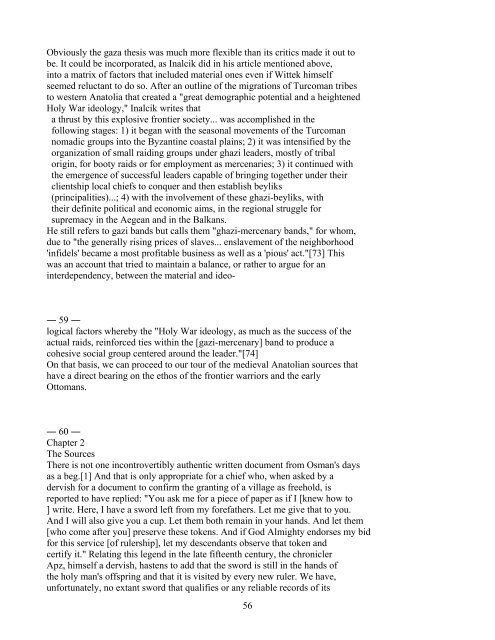Between Two Worlds Kafadar.pdf
Between Two Worlds Kafadar.pdf
Between Two Worlds Kafadar.pdf
You also want an ePaper? Increase the reach of your titles
YUMPU automatically turns print PDFs into web optimized ePapers that Google loves.
Obviously the gaza thesis was much more flexible than its critics made it out to<br />
be. It could be incorporated, as Inalcik did in his article mentioned above,<br />
into a matrix of factors that included material ones even if Wittek himself<br />
seemed reluctant to do so. After an outline of the migrations of Turcoman tribes<br />
to western Anatolia that created a "great demographic potential and a heightened<br />
Holy War ideology," Inalcik writes that<br />
a thrust by this explosive frontier society... was accomplished in the<br />
following stages: 1) it began with the seasonal movements of the Turcoman<br />
nomadic groups into the Byzantine coastal plains; 2) it was intensified by the<br />
organization of small raiding groups under ghazi leaders, mostly of tribal<br />
origin, for booty raids or for employment as mercenaries; 3) it continued with<br />
the emergence of successful leaders capable of bringing together under their<br />
clientship local chiefs to conquer and then establish beyliks<br />
(principalities)...; 4) with the involvement of these ghazi-beyliks, with<br />
their definite political and economic aims, in the regional struggle for<br />
supremacy in the Aegean and in the Balkans.<br />
He still refers to gazi bands but calls them "ghazi-mercenary bands," for whom,<br />
due to "the generally rising prices of slaves... enslavement of the neighborhood<br />
'infidels' became a most profitable business as well as a 'pious' act."[73] This<br />
was an account that tried to maintain a balance, or rather to argue for an<br />
interdependency, between the material and ideo-<br />
― 59 ―<br />
logical factors whereby the "Holy War ideology, as much as the success of the<br />
actual raids, reinforced ties within the [gazi-mercenary] band to produce a<br />
cohesive social group centered around the leader."[74]<br />
On that basis, we can proceed to our tour of the medieval Anatolian sources that<br />
have a direct bearing on the ethos of the frontier warriors and the early<br />
Ottomans.<br />
― 60 ―<br />
Chapter 2<br />
The Sources<br />
There is not one incontrovertibly authentic written document from Osman's days<br />
as a beg.[1] And that is only appropriate for a chief who, when asked by a<br />
dervish for a document to confirm the granting of a village as freehold, is<br />
reported to have replied: "You ask me for a piece of paper as if I [knew how to<br />
] write. Here, I have a sword left from my forefathers. Let me give that to you.<br />
And I will also give you a cup. Let them both remain in your hands. And let them<br />
[who come after you] preserve these tokens. And if God Almighty endorses my bid<br />
for this service [of rulership], let my descendants observe that token and<br />
certify it." Relating this legend in the late fifteenth century, the chronicler<br />
Apz, himself a dervish, hastens to add that the sword is still in the hands of<br />
the holy man's offspring and that it is visited by every new ruler. We have,<br />
unfortunately, no extant sword that qualifies or any reliable records of its<br />
56













